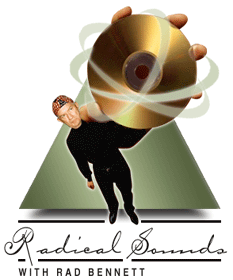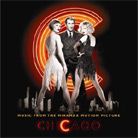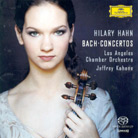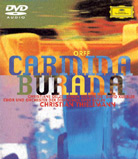 |
| March 1, 2004  Radical
Sounds: Nine High-Resolution Winners Radical
Sounds: Nine High-Resolution Winners
Every time a new format comes along, producers and performers are anxious to get Beethoven’s nine symphonies committed to it, and the two most recent high-resolution formats were quick to have a set. Among Teldec’s very first DVD-Audio releases was a series of the nine with Daniel Barenboim conducting. They were excellent in part, average in sum, and recorded in sound that was entirely too reverberant. That set screamed "Hey Ma, I’ve got surrounds!" as loudly as some of the early two-channel recordings played Ping-Pong: violins hard left, cellos hard right. Deutsche Grammophon has promised to release the last Beethoven cycle Karajan recorded in a 5.1-channel SACD remix. Thanks to Universal Music, I received a new set of the symphonies with Claudio Abbado conducting the Berlin Philharmonic. These brand-new recordings are contained on five DVD-Audio discs -- just the symphonies, no overtures or other fillers. My attitude at first was "Ho-hum, so what?" I had liked Abbado back in his youthful London/Decca days, when he was recording such red-hot discs as the ballet suite from Prokofiev’s Romeo and Juliet and Hindemith’s Metamorphosis on Themes of Carl Maria von Weber. In recent years Abbado seemed to have become complacent, more competent than inspired. But because I am determined to hear anything new that is released in a high-resolution format, I put the first disc on. Was I surprised! These performances were prepared using a new edition of Beethoven’s symphonies prepared by Jonathan Del Mar. Whether it was this, or something in his personal life, or whatever, Maestro Abbado again seems supercharged. The proof is in the listening. This set is as different from Abbado’s Vienna recordings of 15 years ago as black is from white. That earlier cycle seemed indifferent, pedantic, competent, and uninvolved. This one is alive, vital, and exciting. Abbado leads readings that are rhythmically strong but not deficient in lyrical qualities. His tempos are generally brisk without sounding rushed. Articulation is crisp and clean, highlighting one of the biggest advantages of these new readings: phrasing that is crisper and cleaner. It doesn’t hurt that the Berlin Philharmonic is probably the virtuoso ensemble of all orchestras. The woodwind playing is astounding. Such things as the birdcalls at the end of the second movement of Symphony No. 6, or the wind comments on the big tenor solo in the finale of Symphony No. 9, are played with such flair, virtuosity, and subtlety that it seemed as if I was hearing them for the first time. The brasses are right on the mark every time they’re needed, and the strings have a wonderful satiny sound. Special mention should be made of the timpani player, who does far more than beat his instrument. At the climax in the first movement of Symphony No. 9, he accents in such a way that it feels as if all hell is breaking loose. On the other hand, his astute playing during the transition from the third to the fourth movement of Symphony No. 5 makes that passage more suspenseful than ever. The recorded sound seems just right to me. The clarity is impressive, as is the presence of all sections. And the strings, woodwinds, and brass seem perfectly placed and balanced. There is just enough reverb in the surrounds to give a sense of space without muddying anything up front, and the center channel anchors the front stage in a significant manner. There is no need to buy this set just because it is one of only two in a new format. You can buy it because it is good, and destined to be placed alongside other great Beethoven cycles. This has been a great month for discovery and listening. In addition to the Beethoven nine, three other high-resolution releases made the cut this month with lots of room to spare:
I loved the movie, but was afraid that, minus the visuals, the album might not live up to the excitement of the film. My fear was unjustified -- this SACD provides a vital and magnificent experience. Renée Zellweger, Catherine Zeta-Jones, and Queen Latifah sound just great without their images being up on the screen. Richard Gere comes off less successfully, but he does have the least significant songs. All of the music is performed with zest and panache. For many, the surround sound will be the big star of this release. Unlike those irritating rock recordings that suddenly highlight an instrument in the rear, calling undue attention to it, the soundfield on Chicago establishes a lush and involving sonic location that is consistent throughout the recording, and that envelops the listener at all times. Most of the important action is up front. In the audio tour de force "Cell Block Tango," the merry murderesses are established all around the listener, but as each singer takes her solo verse, she comes up front, to the center channel. This SACD demonstrates an intelligent use of multichannel sound that we do not encounter often enough. The dynamic range is astounding, the bass solid and exceptionally well-defined. The upper frequencies have punch while sounding sweet -- nothing sounds shrill or unnatural -- and the voices have unusually good presence. I can think of no drawbacks to this disc except that it is not a CD hybrid; you’ll have to have an SACD player to hear it at all. But darn, it sounds so wonderful, it’s almost worth getting a player just to listen.
Hilary Hahn is undoubtedly the best of a handful of young female violin soloists who sprang up five or six years ago. She plays with elegance, precision, and a joie de vivre that immediately put the listener in the palm of her hand. Her Bach is fleet while never sounding rushed or frantic -- it is simply as joyful as can be, making one realize that the "importance" dished out in earlier recordings by famous names was self-imposed; it surely did not come from Bach. Even the minor-key pieces are happy, albeit in a nostalgic way. Hahn’s delight in this music is contagious, and the virtuoso Los Angeles Chamber Orchestra and its conductor, Jeffrey Kahane, have caught a big case of it -- they back Hahn hand in glove. The recording is rich and full yet clean and detailed. For once, the harpsichord is properly balanced. Not having its own separate microphone, as is often the case, it sounds thoroughly natural and perfectly integrated into the ensemble. The rear channels are used sparingly, to create a sense of space and a three-dimensional perception of the front images. The colorful CD booklet is a treat to glance at, but the notes are hard to read when reproduced in black type on a dark blue background.
Carl Orff’s mix of bawdy medieval poetry and 20th-century music has been immensely popular in the age of high fidelity. It was a monaural showpiece, then became a two-channel spectacular, and now has crossed the high-resolution barrier in style. Counting this one, there are now four high-resolution recordings, two each on SACD and DVD-Audio. Both SACDs are on Telarc, and each has much to recommend it. Robert Shaw’s two-channel performance with the Atlanta Symphony boasts an uncommonly fine group of soloists (Judith Blegen, William Brown, Håkan Hagegård), while the later multichannel recording, with the same orchestra and chorus, benefits from the vital leadership of Donald Runnicles. On DVD-A, the Zubin Mehta-led version is easily dismissed for sound that puts too much emphasis in the surrounds at the expense of clarity. All of these versions pale when compared with this new one, which seems to me the ultimate Carmina Burana -- a reading and a recording as good as are humanly possible. Conductor Christian Thielemann focuses on the all-important rhythms that drive this piece without sacrificing a bit of lyricism. He has fine soloists, an excellent chorus and orchestra, and an incredible children’s choir, and he has them all performing at top level. The sound is forward and large, with great impact of full chorus and orchestra sections; but as loud as it gets, the sound never lacks clarity and transparency. The soloists, located primarily in the center channel, have singular presence, as do the chorus and orchestra. The surrounds are used properly: When the music is soft, one scarcely notices them. But as the music swells to fortissimo and the sound bounces off the walls (in this case, the walls of a church), the sound wraps completely around the listener without losing upfront focus. This is the best-recorded Carmina Burana yet, and the best performance since the groundbreaking monaural one from Eugen Jochum a half century ago -- also on Deutsche Grammophon. ...Rad Bennett
Ultra Audio is part of the SoundStage! Network. |
 Soundtrack: Chicago
Soundtrack: Chicago  J.S. Bach: Violin
Concertos in A Minor and E Major, Double Violin Concerto in D Minor,* Concerto for Oboe,
Violin, Strings, and Continuo.
J.S. Bach: Violin
Concertos in A Minor and E Major, Double Violin Concerto in D Minor,* Concerto for Oboe,
Violin, Strings, and Continuo. Orff: Carmina Burana
Orff: Carmina Burana